Tokiwa (train)
|
A JR East E657 series EMU | |
| Overview | |
|---|---|
| Service type | Limited express |
| Status | Operational |
| Locale | Japan |
| Predecessor | Fresh Hitachi |
| First service |
1 June 1958 (Semi-express) 14 March 2015 (Limited express) |
| Current operator(s) | JR East |
| Former operator(s) | JNR |
| Route | |
| Start | Shinagawa |
| End | Iwaki |
| Line used | Ueno-Tokyo Line, Joban Line |
| On-board services | |
| Class(es) | Green + Ordinary |
| Technical | |
| Rolling stock | E657 series EMUs |
| Track gauge | 1,067 mm (3 ft 6 in) |
| Electrification | 1,500 V DC / 20 kV AC, 50 Hz |
The Tokiwa (ときわ) is a limited express service operated by East Japan Railway Company (JR East) between Shinagawa in Tokyo and Iwaki via the Joban Line and Ueno-Tokyo Line since 14 March 2015.[1] The services replaced the former Fresh Hitachi services operated on the Joban Line between Ueno and Iwaki. The Tokiwa train service name was also formerly used for semi-express services operated by Japanese National Railways (JNR) from June 1958 until March 1985.
Service outline
Tokiwa limited express services operate between Shinagawa in Tokyo and Iwaki in Fukushima Prefecture, supplementing the limited-stop Hitachi limited express services formerly named Super Hitachi.[1][2]
Rolling stock
- E657 series 10-car EMUs (March 2015 –)
Former rolling stock
- KiHa 55 series DMUs (June 1955 –)
- 451 series EMUs (October 1962 – March 1985)
 A KiHa 55 series DMU
A KiHa 55 series DMU A 451 series EMU
A 451 series EMU
Formations
Tokiwa trains are formed as shown below, with car 1 at the Tokyo (Ueno/Shinagawa) end. All cars are no-smoking.[3]
| Car No. | 1 | 2 | 3 | 4 | 5 | 6 | 7 | 8 | 9 | 10 |
|---|---|---|---|---|---|---|---|---|---|---|
| Accommodation | Reserved | Reserved | Reserved | Reserved | Green | Reserved | Reserved | Reserved | Reserved | Reserved |
History
The original Tokiwa semi-express service was introduced on 1 June 1958, operating between Ueno in Tokyo and Taira Station (present-day Iwaki Station) in Fukushima Prefecture via the Joban Line using KiHa 55 series diesel multiple unit (DMU) trains.[4] Three return services operated daily.[4] Following electrification of the Joban Line, 451 series electric multiple unit (EMU) trains were introduced on some Tokiwa services from October 1962.[4] Primarily used on Miyagino express services, these formations included buffet cars, although a buffet service was not provided on Tokiwa services.[4]
A typical 11-car 451 series formation (without a buffet car) as used following the October 1978 timetable revision is shown below.[5]
| Car No. | 1 | 2 | 3 | 4 | 5 | 6 | 7 | 8 | 9 | 10 | 11 |
|---|---|---|---|---|---|---|---|---|---|---|---|
| Designation | KuHa 451 | SaRo 451 | MoHa 450 | KuMoHa 451 | SaHa 451 | MoHa 450 | KuMoHa 451 | KuHa 451 | SaRo 451 | MoHa 450 | KuMoHa 451 |
- Cars 2 and 9 were "Green (first class) cars.
From 5 March 1966, Tokiwa services were upgraded from "semi express" to "express" status.[4] From the start of the revised timetable on 14 March 1985, Tokiwa services were absorbed into Hitachi limited express services, and the name was discontinued.[4]
See also
References
- 1 2 上野東京ライン開業に伴い、常磐線特急はより快適に、より使いやすい特急に生まれ変わります。 [Joban Line limited express services to become faster and more convenient with opening of Ueno-Tokyo Line] (PDF). News release (in Japanese). Japan: East Japan Railway Company. 30 October 2014. Retrieved 30 October 2014.
- ↑ 「上野東京ライン」開業により、南北の大動脈が動き出します [North-south artery comes into operation with opening of Ueno-Tokyo Line] (PDF). News release (in Japanese). Japan: East Japan Railway Company. 30 October 2014. Retrieved 30 October 2014.
- ↑ JR Timetable. Japan: Kotsu Shimbunsha. February 2015. EAN 4910053110259.
- 1 2 3 4 5 6 Teramoto, Mitsuteru (23 July 2001). 国鉄・JR列車名大辞典 [JNR & JR Train Name Encyclopedia]. Tokyo, Japan: Chuoshoin Publishing Co., Ltd. pp. 385–387. ISBN 4-88732-093-0.
- ↑ 写真とイラストで見る国鉄急行型電車のすべて [JNR Express EMUs in pictures] (in Japanese). Japan: Neko Publishing Ltd. 29 November 2013. pp. 96–97. ISBN 978-4-7770-1532-0.
External links
- Official website (Japanese)

.svg.png)